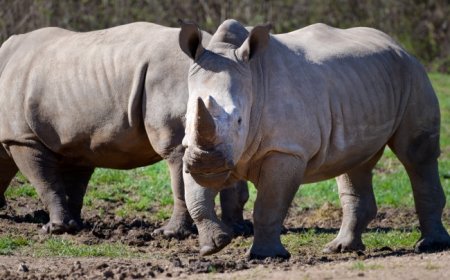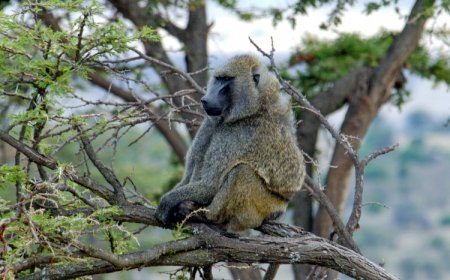All About Chimpanzees for Students: Smart, Social, and Wild
Explore the life of chimpanzees in this educational article for students aged 8–16. Learn about their intelligence, behavior, diet, and conservation needs. Includes vocabulary, quiz, and summary!

🧠🐒 Chimpanzees: Smart, Social, and Wild
Chimpanzees are more than just fascinating animals—they are our closest living relatives, sharing nearly 98.7% of our DNA. These great apes are known for their intelligence, emotion, and complex behavior. They live in tight-knit communities, solve problems, use tools, and even form friendships. Watching a chimpanzee is a bit like watching a wild version of ourselves.
Chimps live in tropical forests across central and West Africa. They swing through trees and walk on all fours across the forest floor. They're fast, strong, clever, and full of personality. But despite their amazing abilities, chimpanzees are facing serious threats in the wild and need our help to survive.
🌍 Habitat and Distribution
Chimpanzees live in a variety of environments in central and western Africa, including:
- Tropical rainforests
- Woodlands and savannas
- Mountain forests and river valleys
They are found in more than 20 countries, including Uganda, Congo, Cameroon, Gabon, and Ivory Coast. They prefer areas with tall trees and thick vegetation where they can build nests, search for food, and hide from predators.
Although chimpanzees are comfortable on the ground, they spend a lot of time in trees. At night, they build leafy nests high in the branches to sleep safely away from leopards, snakes, or other threats. Each chimp builds a new nest every night, folding and weaving leaves and branches into a cozy platform.
🍌 Diet and Feeding Behavior
Chimpanzees are omnivores, which means they eat both plant and animal foods. Their diet is wide-ranging and includes:
- Fruits like figs, bananas, and berries
- Leaves and flowers
- Nuts, seeds, and bark
- Insects, such as ants and termites
- Occasionally meat, including monkeys, small antelope, and bird eggs
What makes chimps special is the way they use tools to get food. They strip leaves from branches to create termite sticks, which they dip into termite mounds. They also crack open nuts with rocks and use chewed-up leaves as sponges to drink water from tree holes.
Young chimpanzees learn by watching their mothers and other chimps. This is called observational learning, and it’s a sign of advanced intelligence.
👥 Social Structure and Communication
Chimpanzees live in large communities called troops or fission-fusion groups. These groups may include 20 to over 100 chimps, but individuals come and go throughout the day. The group has a dominant male, but leadership depends on more than just strength—it also involves forming alliances and building trust.
Chimps have one of the most advanced social systems in the animal world. They:
- Groom each other to build friendships
- Share food
- Help raise each other’s babies
- Use facial expressions, hand gestures, and over 30 vocal sounds to communicate
- Laugh when playing and scream when scared
Each chimpanzee has its own personality. Some are gentle and playful, while others are bold and competitive. Mothers form deep bonds with their babies and stay close for many years.
🍼 Life Cycle and Family Life
Female chimpanzees can give birth about every 5–6 years, which is slow compared to other animals. Their pregnancies last about 8 months, and they usually give birth to a single baby.
A newborn chimpanzee clings to its mother's belly and later rides on her back. Babies stay very close to their mothers for the first 2–3 years, nursing, learning, and playing. Even when they grow more independent, they often stay in their mothers’ group for life.
Chimps become fully grown at around 12–15 years old. They can live up to 50 years in the wild and longer in sanctuaries or zoos. Young chimps play constantly, wrestling, chasing, and climbing—important behaviors for learning and socializing.
🧠 Intelligence and Tool Use
Chimpanzees are among the most intelligent animals on Earth. In the wild, they show creativity, memory, and planning. In captivity, they have been taught basic sign language, can solve puzzles, and remember symbols and numbers.
Examples of chimp intelligence:
- Making tools to fish for termites
- Planning hunting strategies with others
- Using sticks to test water depth or scare snakes
- Recognizing themselves in mirrors (a sign of self-awareness)
- Showing empathy, such as comforting a sad group member
Chimpanzees don’t just survive—they think, learn, and problem-solve in ways that make scientists believe they are capable of culture, emotion, and even morality.
⚠️ Threats and Conservation
Despite their intelligence and social complexity, chimpanzees are in danger. The IUCN lists them as endangered, and their population has dropped by more than 50% in the past 60 years.
🛑 Major threats:
- Habitat destruction for logging, farming, and mining
- Illegal poaching, including capturing infants for the pet trade
- Diseases like Ebola, which spread between humans and apes
- Conflict with humans, especially in areas where forests are disappearing
🌍 Conservation efforts:
- Protecting forests and creating wildlife corridors
- Banning hunting and trafficking of chimpanzees
- Supporting sanctuaries like Tacugama in Sierra Leone and Ngamba Island in Uganda
- Teaching communities about the value of wildlife
International organizations like Jane Goodall Institute and Wildlife Conservation Society are leading the way in protecting chimps and their homes.
🎉 Fun Facts About Chimpanzees
- Chimps share almost 99% of their DNA with humans
- They kiss, hug, tickle, and hold hands
- A chimp’s scream can be heard for miles through the forest
- They build nests high in trees every night
- Chimps have been observed using medicinal plants when sick
🧠 Vocabulary List
- Omnivore – An animal that eats both plants and animals
- Troop – A group of chimpanzees living together
- Fission-fusion group – A social group that changes size throughout the day
- Observational learning – Learning by watching others
- Tool use – Using objects to help solve problems or get food
- Self-awareness – Knowing who you are (tested using mirrors)
- Endangered – At risk of extinction
- Sanctuary – A safe place for rescued or protected animals
- Habitat destruction – Damage to an animal’s natural home
- Empathy – Understanding and caring about someone else’s feelings
🧒 Kid-Friendly Summary
Chimpanzees are smart, playful apes that live in African forests. They use tools, talk with gestures and sounds, and live in big family groups. Chimps eat all kinds of food and love to play, cuddle, and groom each other.
Sadly, chimpanzees are in danger because their homes are being cut down and some are hunted. But scientists and helpers all over the world are working hard to protect chimps and keep them safe in the wild. These amazing animals are our wild cousins—and they need our help.






















































